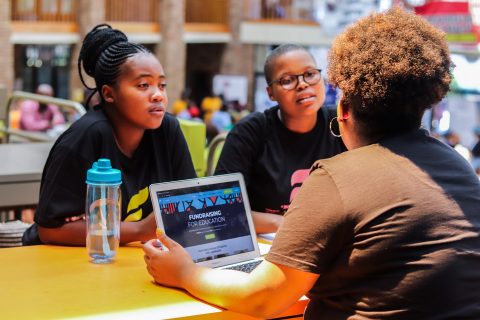Magazine Cover
#Feesmustfall – Now What?
After the much publicised #FeesMustFall student protests, government committed to footing R1.9-billion of the R2.3-billion shortfall for their no-fee increase decision taken in 2016. But this begged the question: what happens next year, and the year thereafter? Keeping in mind that the cost of operating most higher education institutions typically increases faster than either inflation or growth in the economy. On top of this, the number of students enrolling each year places an even heavier burden on that decision.
More than R4.5-billion was reprioritised to the National Student Financial Aid Scheme (NSFAS) in 2016.
The National Skills Fund allocated almost R1.4-billion for 2016, and the higher education budget will rise from R42-billion in 2015/16 to R55-billion in 2018/19 – but there is still a shortfall.
In October 2015, President Jacob Zuma set up The Commission of Inquiry into Higher Education and Training (The Fees Commission), to investigate the feasibility of free higher education in South Africa.
Various parties made presentations, with the focus on innovative ways to fund education. National Treasury’s submission detailed the constraints the body is facing currently, such as limited economic growth and increasing demands on the fiscus.
Dr Ramos Mabugu, research and recommendations programme director at the Financial and Fiscal Commission (FFC)‚ an independent constitutional advisory body‚ points out that returns on education have both social and private beneficiaries‚ so there is always a private and a social component.
In its presentation to the Commission, FFC said: “Given that the student protests were sparked by a mere 10 per cent increase in 2016‚ an additional R4-billion needs to be covered. Free university education‚ given the current figures‚ would require the injection of an additional R40-billion from the public purse to the tertiary education sector.”
The FFC suggested a mixed bag of funding models for access to higher education for the poor‚ including raising value-added tax by around 0.6 per cent (from 14 per cent to 14.6 per cent), and the personal income tax by between one per cent and five per cent‚ levying a R167 per annum tax on graduates, and through donations from the alumni and corporate donors. All of these suggestions, however, have their own set of challenges.
Wits University proposed a model that includes public-private partnerships that source funding from the government as well as from the private sector. Such funding could be a complement to the current system, or it could be enhanced through the use of financial instruments and special-purpose entities.
The university’s position is that a multi-faceted approach is required in which government, the private sector and university revenues (fees, donor funds and endowments) all contribute in various ways to the general well-being and sustainability of the higher education sector as a whole.
The statistics and figures provided by Wits show that the Faculty of Humanities currently receives the largest amount of donations. The largest donor to this faculty is the Andrew W. Mellon Foundation, which donated R18-million in 2015, a figure that is nearly double the R9.4-million that it donated in 2014. The second largest donor is the Ford Foundation, with R4.2-million.
Xhanti Payi, economist at research and advisory firm Nascence Advisory, says that the challenge of educating students with less funds from fees means that universities need to do a very serious review of how they do business. “This review would start from how they value the product or service they provide – what it cost to provide a course to which price to put on all other university facilities, from sports to arts. This may help in dealing with the discussion of rising fees which seem to trouble so many.”
Payi asserts that tapping into the private sector is vital, due to it having vast financial resources, the value of which can’t be underestimated. He also highlights the pool of expertise in corporate South Africa, “in terms of crafting creative solutions to the fees issue”.
North-West University suggested a subsidised funding framework to the commission. This model would see NSFAS applied as a government loan fund available to all students, and not only the poor, by implementing a sliding scale based on the individual tax tables. This scheme would formalise requirements to qualify for a government loan fund through the South African Revenue Service, and reward academically deserving students with merit bursaries to reduce the loan balance for tuition fees.
The University of Johannesburg, on then other hand, suggested upping the higher education budget to one per cent of gross domestic product (GDP). Based on this estimate, the allocation during 2015/2016 would be R41-billion versus the R30-billion that was provided, which asserts that the difference of an additional R11-billion would make a major difference to the sector. Currently, the South African government spends just 4.7 per cent of revenue, or 0.75 per cent of GDP, on the post-school education and training sector.
The University of Zululand proposed that the way forward lies in cost sharing between government, tertiary institutions and the private sector. They also suggested looking to income generation as a possible means to bridging the gap. The institution asserted that “since it is impossible for the state to meet all the financing needs of tertiary institutions, it is necessary for higher education institutions to increase their non-governmental sources of income in a systematic manner, to sustain the same or higher levels of expenditure, or find ways of reducing costs and simultaneously increasing efficiency in the context of definitive arrangements reached with government.”
Through its core business of teaching, learning and research, the institution envisaged developing self-generating sources of income, such as credit bearing or certificate-type short courses offered to the public and private sector, pointing out that many tertiary institutions are already offering such programmes. Another option would be to develop specialised degree or diploma programmes that are specifically designed for particular public or private institutions and are fully funded by them – for example, a degree in co-operatives or a master’s degree in rural integrated development. They also suggested harnessing commercial opportunities in activities associated with the university, to generate an additional revenue stream.
Things such as restaurants, hiring of facilities, bookstores, and developing a mini mall inclusive of a petrol station on campus.
The National Research Foundation presented to the commission that a more affordable and sustainable solution is one that funds students on the basis of cost of study, but this is selective and differentiates on the basis of certain principles and/or guidelines, with selectivity informed by focus/priority areas and transformation imperatives and targets. This differentiation will categorise students for full, partial or no funding, depending on income levels and access to other funding such as bursaries.
Third-stream income, which refers to all income derived from sources other than public subsidies and student fees for tuition or accommodation, has been bandied about by universities. For instance, The University of the Western Cape’s Business Innovation Centre has been established and introduced as the vehicle for managing the implementation of the third-stream income strategy, consolidating existing efforts to develop a strong and diversified financial base.
It would seem that the unintended outcome of the #FeesMustFall movement has alerted universities and other tertiary institutions that it is time to rethink how they operate, so that they become sustainable and independent in the long term.





 Sign-up and receive the Business Media MAGS newsletter OR SA Mining newsletter straight to your inbox.
Sign-up and receive the Business Media MAGS newsletter OR SA Mining newsletter straight to your inbox.